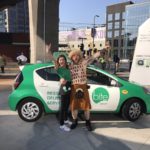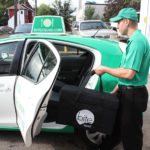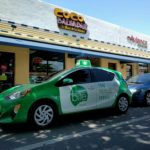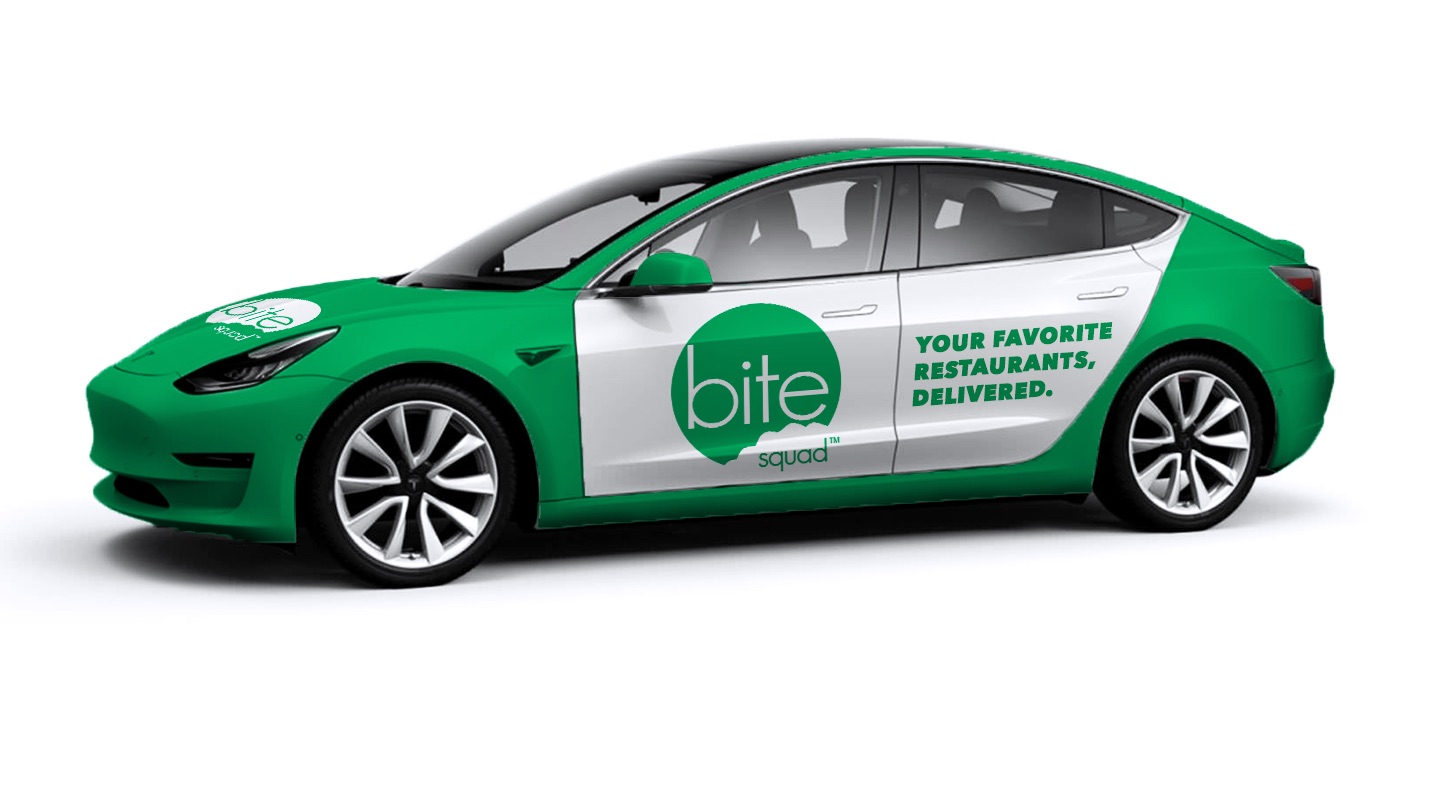
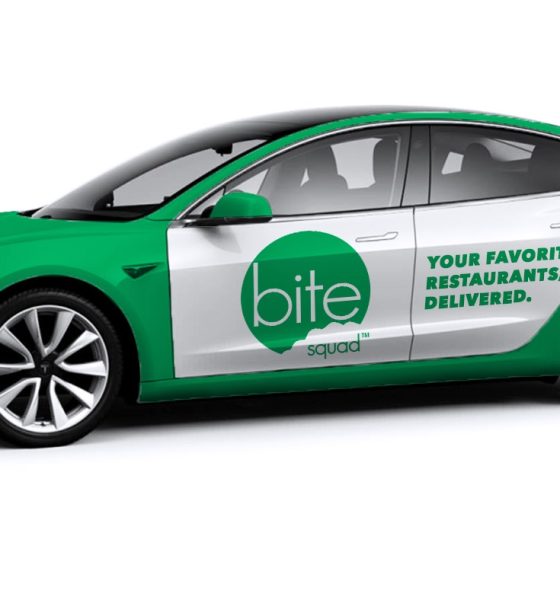
Lifestyle
Food delivery service turns to Tesla Model 3 in bid to replace Prius fleet and go emissions-free
Online food delivery service Bite Squad is looking to replace its fleet of Toyota Prius delivery cars with the Tesla Model 3 within the next few years. The food delivery startup plans to test the mass market compact sedan later this year, and if the Model 3 meets the company’s expectations, Bite Squad will be fully transitioning its fleet of hybrid delivery cars to the all-electric compact sedan.
Bite Squad’s Model 3 announcement was posted on the company’s blog earlier this month, with CEO Kian Salehi stating that Tesla’s newest vehicle can play a vital role in the company’s aim of having a fully emissions-free fleet. Currently, Bite Squad, which operates on 30 markets across the United States, utilizes a fleet of Toyota Priuses for its food deliveries. While the hybrids provide great fuel economy, however, the Bite Squad CEO stated that the all-electric Model 3 could provide an even cleaner, greener option.
“Our existing hybrid cars significantly cut emissions, but an all-electric fleet would be completely emissions-free. This is where we want to be.
“When we launched in 2012, the goal was to reduce the environmental impact of our fleet by using as many hybrid vehicles as we could. The goal is the same today, but the technology has changed. We now have an opportunity to further reduce our impact with an affordable battery-powered car.”
Bite Squad’s Toyota Prius fleet currently comprises roughly 10% of the company’s delivery vehicles. The rest of the cars deployed for the service are owned by Bite Squad’s drivers, who use their personal vehicles to deliver food to customers.
In a statement to the Star Tribune, Craig Key, Bite Squad’s VP for marketing, noted that the Model 3 could give the company great benefits and savings in the long run. While the mass market electric compact sedan is more expensive than a Toyota Prius, its all-electric drivetrain completely negates fuel expenses and reduces maintenance costs.
Key further noted that the food delivery startup is looking forward to the rollout of the Model 3’s full self-driving capabilities. While the VP did state that a driverless food delivery service is not in the company’s plans for the near future, the autonomous features of the Model 3 would likely reduce the number of accidents that its vehicles will be involved in on the road.
“We think it could be a big game-changer for us both in terms of cost and liability and safety,” the Bite Squad VP said.
For now, however, Key stated that just like all other Model 3 reservation holders, the company is just waiting for Tesla to deliver its electric cars. Bite Squad placed reservations for the electric car last year, and while their vehicles’ delivery dates were initially set to late 2018, the subsequent delays in the production ramp-up of the Model 3 would likely push the delivery dates of the company’s new cars well into 2019.
As we noted in a previous article, Tesla has adjusted its expectations for the ramp-up of Model 3 deliveries during the California-based electric car firm’s Q4 2017 delivery report, with CEO Elon Musk moving the 5,000 a week production goal to the end of the second quarter. The 5,000-unit-per-week goal was initially set for the end of 2017.

Lifestyle
Tesla Model S Plaid battles China’s 1500 hp monster Nurburgring monster, with surprising results
There is just something about Tesla’s tuning and refinement that makes raw specs seem not as game-changing.

The Tesla Model S Plaid has been around for some time. Today, it is no longer the world’s quickest four-door electric sedan, nor is it the most powerful. As per a recent video from motoring YouTube channel Carwow, however, it seems like the Model S Plaid is still more than a match for some of its newer and more powerful rivals.
The monster from China
The Xiaomi SU7 Ultra is nothing short of a monster. Just like the Model S Plaid, it features three motors. It also has 1,548 hp and 1,770 Nm of torque. It’s All Wheel Drive and weighs a hefty 2,360 kg. The vehicle, which costs just about the equivalent of £55,000, has been recorded setting an insane 7:04.957 at the Nurburgring, surpassing the previous record held by the Porsche Taycan Turbo GT.
For all intents and purposes, the Model S Plaid looked outgunned in Carwow’s test. The Model S Plaid is no slouch with its three motors that produce 1,020 hp and 1,420 Nm of torque. It’s also a bit lighter at 2,190 kg despite its larger size. However, as the Carwow host pointed out, the Model S Plaid holds a 7:25.231 record in the Nurburgring. Compared to the Xiaomi SU7 Ultra’s record, the Model S Plaid’s lap time is notably slower.
Real-world tests
As could be seen in Carwow’s drag races, however, Tesla’s tech wizardry with the Model S Plaid is still hard to beat. The two vehicles competed in nine races, and the older Model S Plaid actually beat its newer, more powerful counterpart from China several times. At one point in the race, the Xiaomi SU7 Ultra hit its power limit due to its battery’s temperature, but the Model S Plaid was still going strong.
The Model S Plaid was first teased five years ago, in September 2020 during Tesla’s Battery Day. Since then, cars like the Lucid Air Sapphire and the Xiaomi SU7 Ultra have been released, surpassing its specs. But just like the Model Y ended up being the better all-rounder compared to the BYD Sealion 7 and the MG IM6, there is just something about Tesla’s tuning and refinement that makes raw specs seem not as game-changing.
Check out Carwow’s Model S Plaid vs Xiaomi SU7 drag race video below.
Lifestyle
500-mile test proves why Tesla Model Y still humiliates rivals in Europe
On paper, the BYD Sealion 7 and MG IM6 promised standout capabilities against the Model Y.

BYD is seeing a lot of momentum in Europe, so much so that mainstream media has taken every opportunity to argue that the Chinese automaker has beaten Tesla in the region. But while BYD sales this year in Europe are rising and Tesla’s registrations remain challenged, the raw capabilities of vehicles like the Model Y are difficult to deny.
This was highlighted in a 500-mile challenge by What Car? magazine, which showed that the new Tesla Model Y is more efficient, cheaper to run, and more reliable than rivals like the BYD Sealion 7, and even the nearly 400 KW-charging MG IM6.
Range and charging promises
On paper, the BYD Sealion 7 and MG IM6 promised standout capabilities against the Model Y. The Sealion 7 had more estimated range and the IM6 promised significantly faster charging. When faced with real-world conditions, however, it was still the Model Y that proved superior.
During the 500-mile test, the BYD nearly failed to reach a charging stop, arriving with less range than its display projected, as noted in a CarUp report. MG fared better, but its charging speeds never reached its promised nearly-400 kW charging speed. Tesla’s Model Y, by comparison, managed energy calculations precisely and arrived at each stop without issue.
Tesla leads in areas that matter
Charging times from 25% to 80% showed that the MG was the fastest at 17 minutes, while Tesla and BYD were close at 28 and 29 minutes, respectively. Overall efficiency and cost told a different story, however. The Model Y consumed 19.4 kWh per 100 km, compared to 22.2 for MG and 23.9 for BYD. Over the full trip, Tesla’s charging costs totaled just £82 thanks to its supercharger network, far below BYD’s £130 and MG’s £119.
What Car? Magazine’s testers concluded that despite BYD’s rapid sales growth and the MG IM6’s seriously impressive charging speeds, Tesla remains the more compelling real-world choice. The Model Y just offers stability, efficiency, and a proven charging infrastructure through its Supercharging network. And as per the magazine’s hosts, the Model Y is even the cheapest car to own among the three that were tested.
Watch What Car? Magazine’s 500-mile test in the video below.
Lifestyle
Tesla Cybertruck slapped with world’s least intimidating ticket, and it’s pure cringe
One cannot help but cringe and feel second-hand embarrassment at the idea of a person just driving around with a stack of these babies.

A Cybertruck parked at Stanford Shopping Center in California was recently hit with what might be the most try-hard piece of paper ever slipped under a wiper blade: a “fake citation” accusing the driver of supporting a “fascist car.”
The note, shared on X by Tesla staff program manager Ryan Torres, quickly made the rounds on X, where it quickly gained attention as an example of how not to protest.
The world’s least intimidating ticket
According to the citation, the supposed “violation” was “driving a fascist car.” The remedial action? Take the bus, call an Uber, or ride a bike. The note also dubbed Elon Musk a “chainsaw-wielding Nazi billionaire.” Now, protests against Tesla and Elon Musk have become commonplace this year, but one cannot help but cringe and feel second-hand embarrassment at the idea of a person just driving around with a stack of fake anti-Tesla/Musk citations.
Torres pointed out the irony himself in his post on X. Tesla currently employs over 140,000 Americans, and SpaceX has put the U.S. firmly back at the top of space technology. As Torres put it, maybe the person behind the world’s least intimidating ticket should “read a book on innovation before vandalizing” other people’s property.
Peak performative clownery
Not to mention that the fake ticket’s logic collapses under its own weight. EVs like the Cybertruck are literally designed to reduce emissions, not “destroy the economy.” If anything, Tesla has bolstered the United States’ economy by fueling jobs in engineering, manufacturing, and clean energy. It’s not the first time a Tesla has been the target of vandalism or politically charged notes, but this one stands out for sheer cringe value.
Torres summed it up neatly: “Peak clownery.” On that point, at least, the citation earns full marks. In a way, though, perhaps cringe fake tickets are not as bad as the literal firebombs that were being thrown at Tesla stores and cars earlier this year because some critics were gleefully misinformed about Elon Musk.
